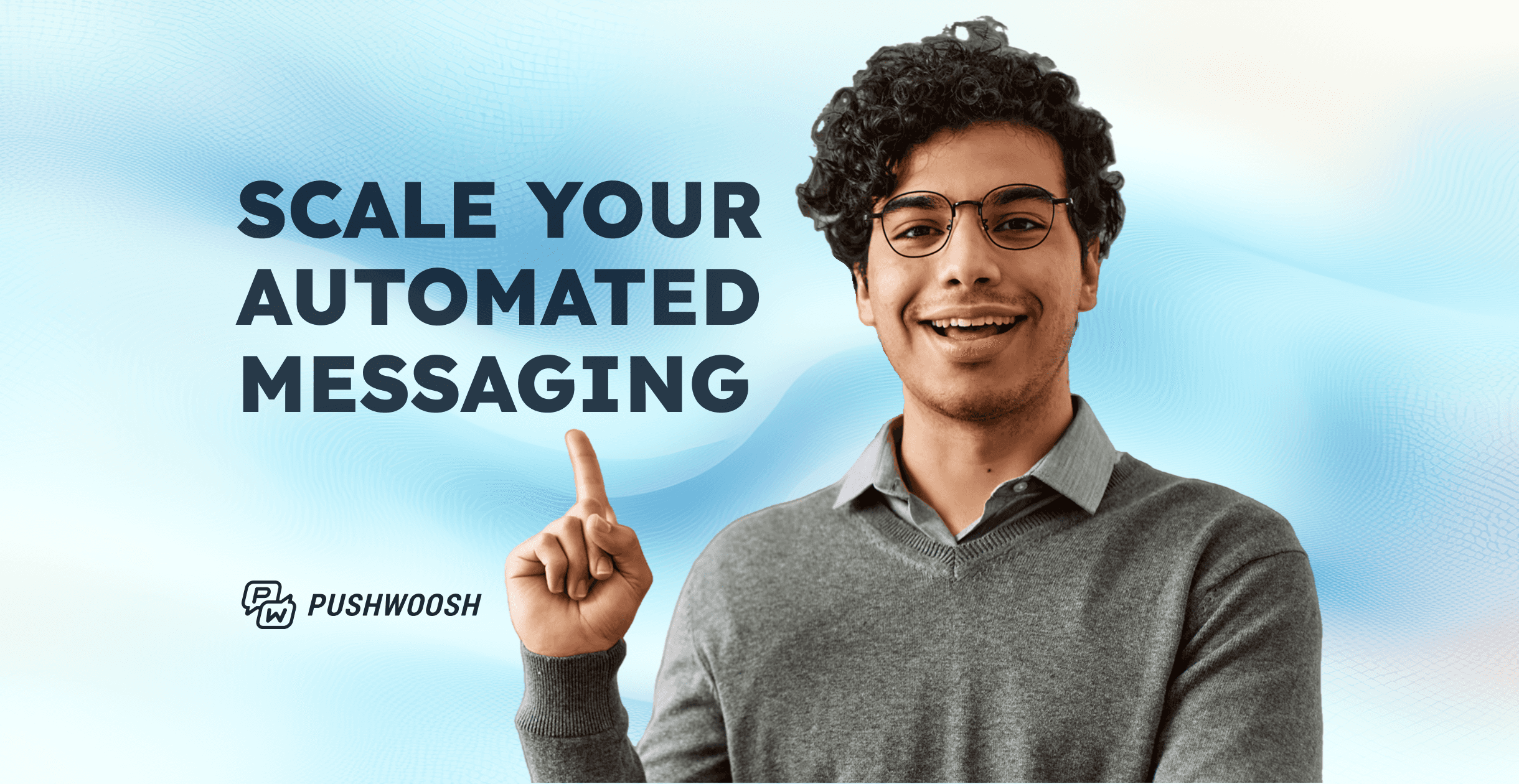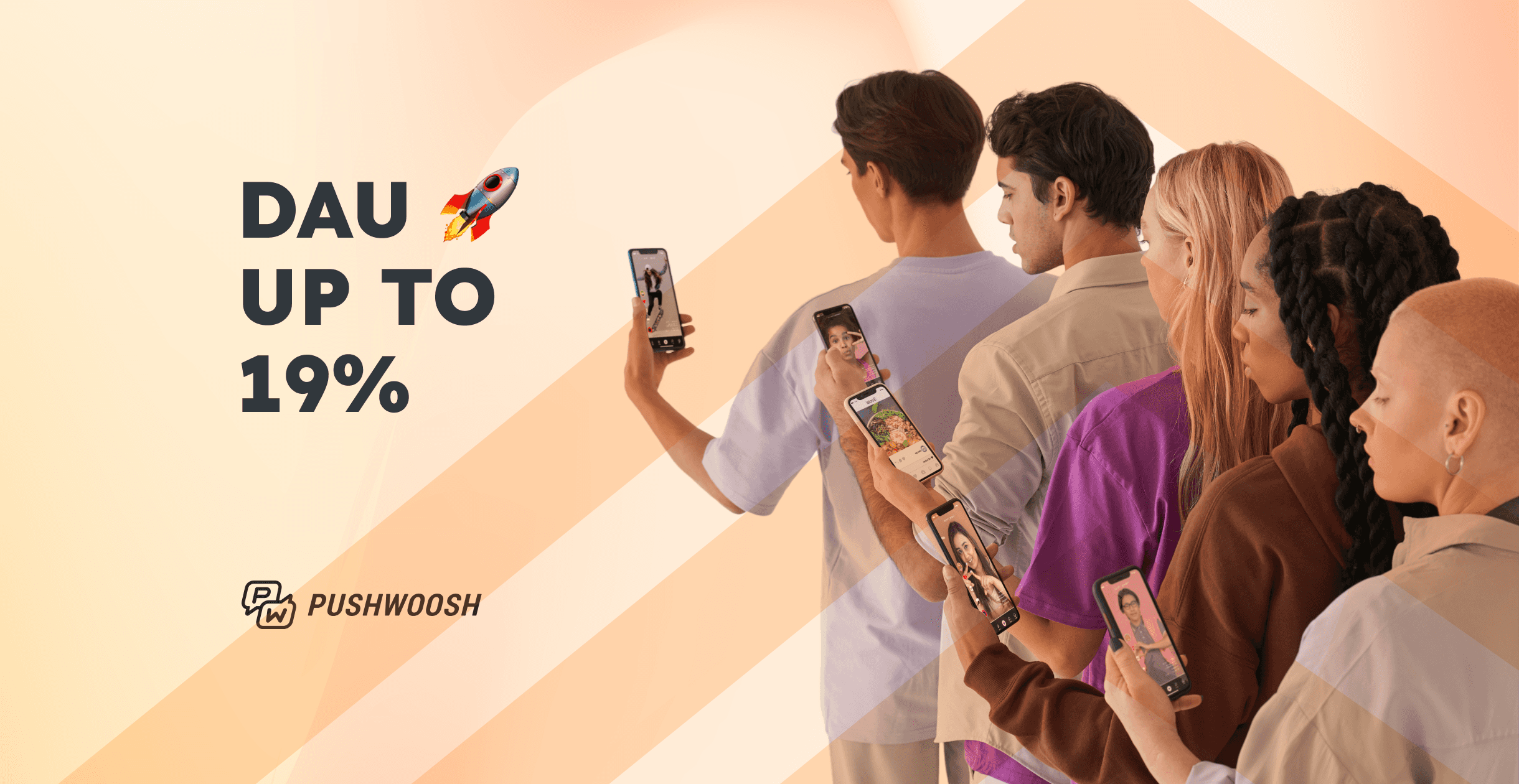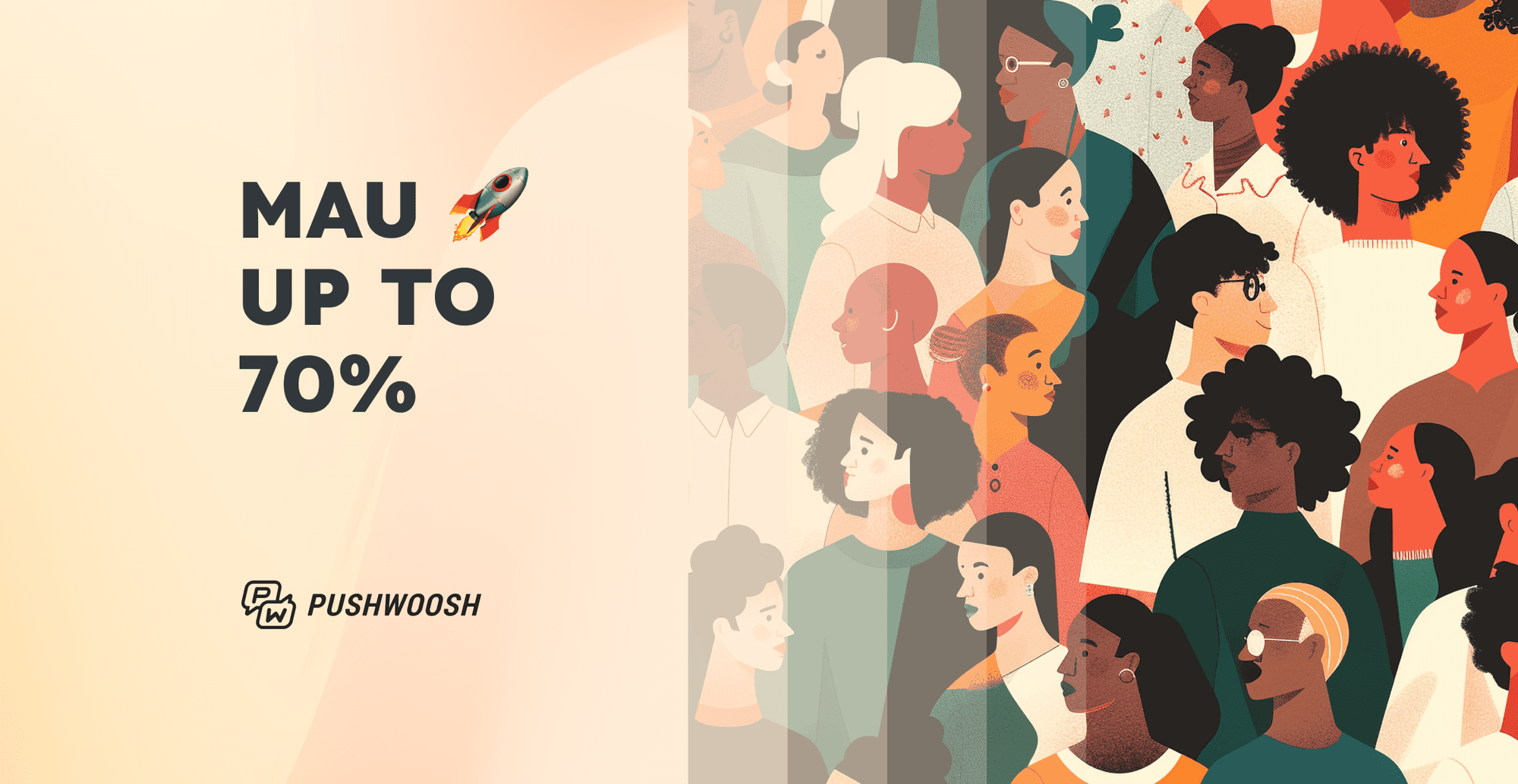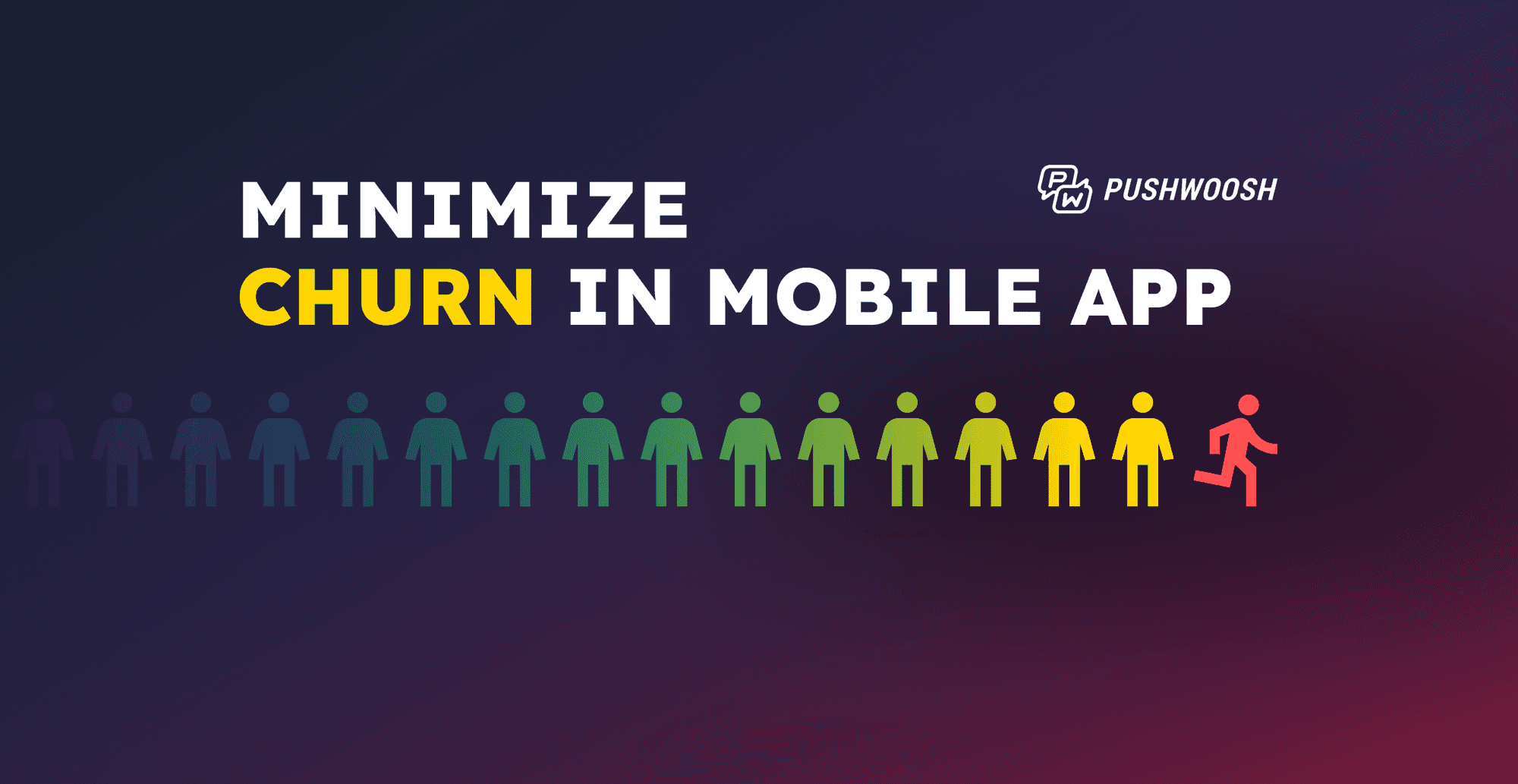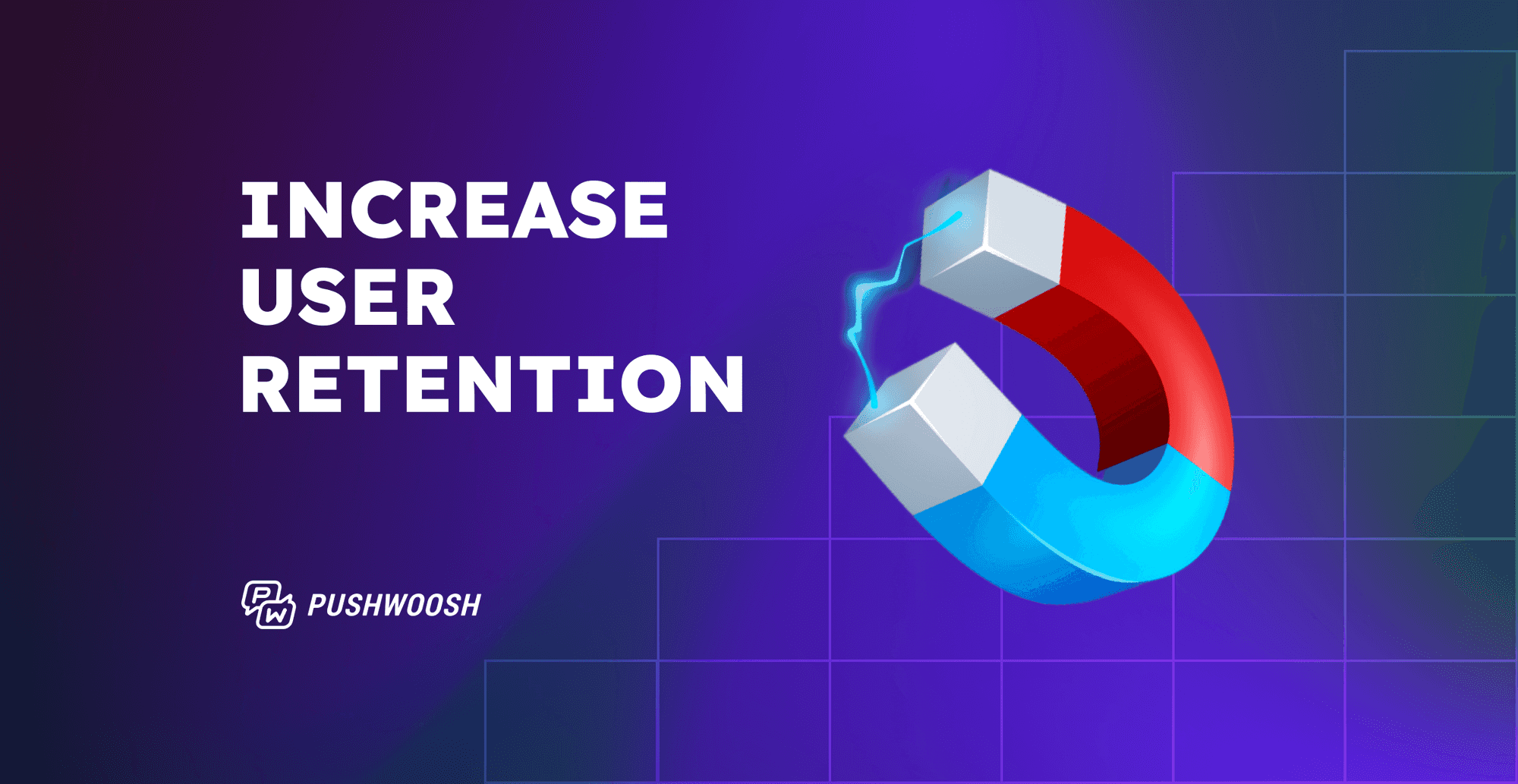Marketing automation for mobile apps: A guide for teams that have outgrown their tools
Retention is the new growth lever—and automation is how you scale it.
But for mobile apps, the playbook looks different.
You’re working with event-based flows, fragmented channels, and users who expect speed and personalization by default.
That early tool you set up might’ve worked fine at launch. But fast-forward to now, and you’re probably feeling the friction.
Messages don’t trigger on time. Journeys break. Data’s scattered. The cracks show up fast once your app matures.
This guide unpacks:
- What mobile marketing automation really means (beyond basic push flows)
- The core components of scalable mobile automation workflows
- The lifecycle use cases that drive engagement and retention
- What to look for in a tool that’s built for speed and scale
What is mobile marketing automation, exactly?
Mobile marketing automation means building responsive, real-time journeys that adapt to user behavior inside your app.
It connects event-driven messaging with mobile-native channels like push, in-app, SMS, and more, so every message hits with the right context and timing.
In other words, mobile-first tools fire campaigns based on what users actually do. Like:
Opening a screen
Using a specific feature
Dropping off before converting
These platforms integrate directly with in-app events to move fast, act contextually, and stay native.
Watch for tools that treat in-apps like an afterthought. They weren’t designed with mobile UX in mind, and this shows in brittle flows, slow syncs, and poor user targeting.
The key components of mobile marketing automation
When teams talk about “scaling personalization,” they usually need a better engine. One that reacts fast, hits the right channel, and speaks to the user’s real behavior.
Here’s what that looks like in practice:
⚡Real-time data collection
To act in the moment, you need to see the moment. Real-time tracking in mobile automation platforms lets your campaigns react instantly. For example, by nudging a user who abandoned a key flow, not two days later, but two seconds after.
⚡Trigger-based workflows.
The best user journeys are responsive: triggered by behaviors, not calendars. If a user opens the app but doesn’t complete setup, that’s the moment to intervene.
⚡Mobile-native channels, in sync.
Push, in-app, SMS, even WhatsApp. Mobile users don’t think in silos, and your messaging shouldn’t either. Strong automation brings these together into one logic, so you’re not duct-taping flows across tools.
Why marketing automation is critical for mobile app growth
Let’s be honest: acquiring users means nothing if they ghost you a week later.
Marketing automation is the difference between users who stick around and those who delete your app after two sessions.
It lets you activate, re-engage, and retain customers you have already attracted.
Done right, automation helps you:
Speed up onboarding: Guide users to early wins, right when they need it
Bring dormant users back: Trigger messages based on inactivity and decreasing engagement
Nudge behavior in real time: Prompt the next step based on what users are doing (or not doing)
Create dynamic, personalized campaigns: Deliver messaging that adapts to user context, not static segments
Let’s look at an example.
Bladestorm—an app for gamers—hit a ceiling with user acquisition and shifted its focus to marketing automation.
With Pushwoosh, they doubled down on engagement by implementing recurring offers and behavior-based nudges. For example, they set up automated workflows targeting segments like users who hadn’t opened the app in three days.

The result they achieved? A 4.58% revenue lift and 16.6% MAU growth in just eight months.
Key channels for mobile app automation
Effective mobile app automation engages users with personalized experiences through the right channels at the right time.
Push notifications
These are your direct line when users aren’t in your app.
Push notifications work best for immediate action—cart abandonment alerts, limited-time offers, and bringing back dormant users.
Here’s an automated push notification Uber Eats sends to drive users back to the app:

In-app messages
In-app messages are the best tool for users already engaged with your app. They come in several main formats like:
- Sticky banners: Subtle in-app guidance without disrupting experience
- Full-screen takeovers: For major announcements and critical updates
- Interactive stories: Step-by-step walkthroughs for complex features or onboarding
Here’s how Waze uses interactive stories to onboard new users:
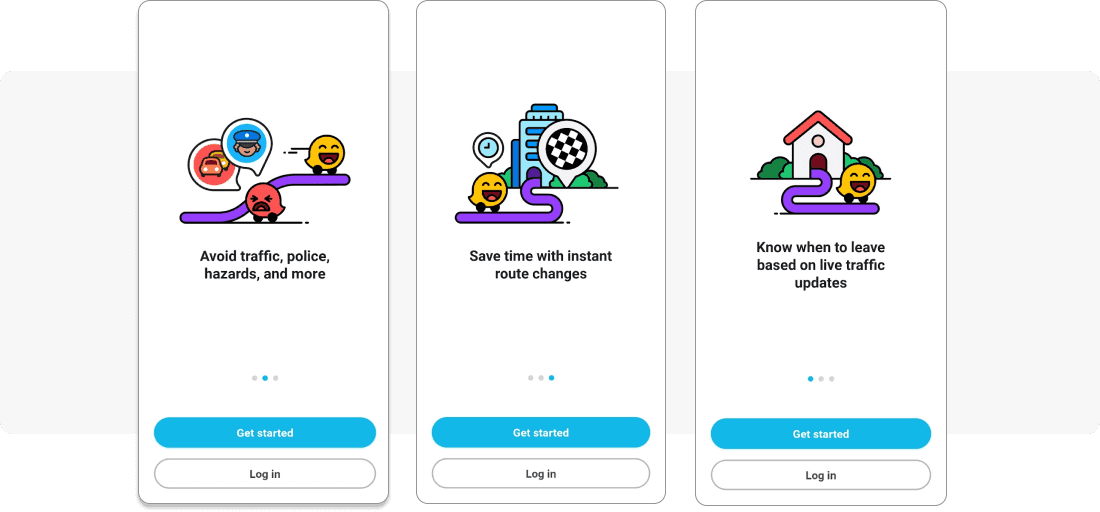
Triggered email campaigns are perfect for longer content, comprehensive updates, and as a fallback when push notifications fail.
They also give you space to provide complete information about your offers and add multiple CTAs.
For instance, here’s how HUX uses their abandoned cart email to remind users how quick and effortless the transaction can be:
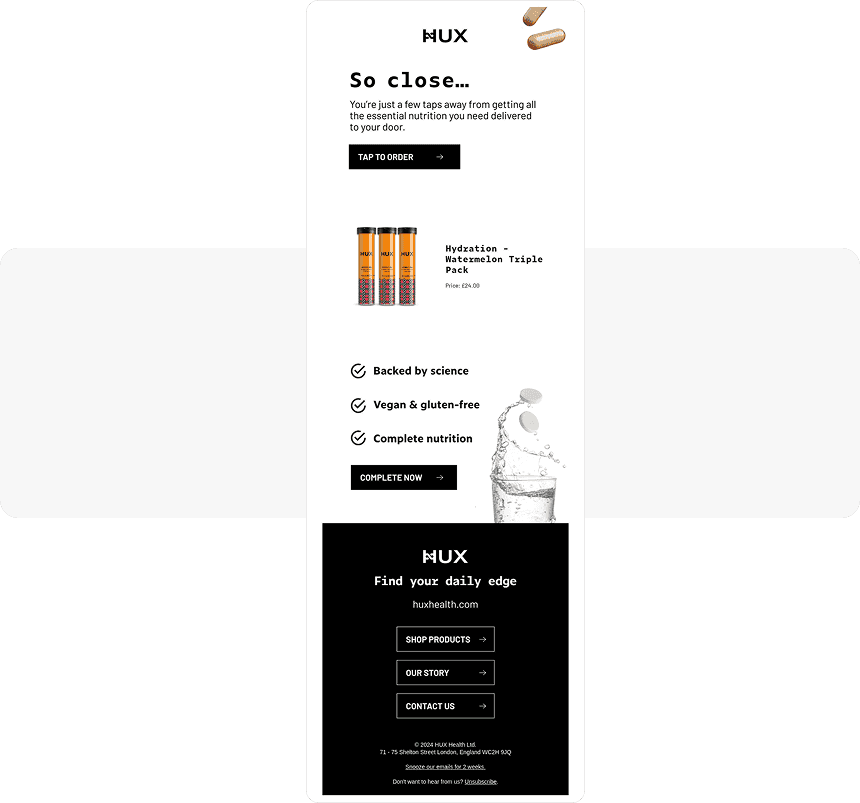
SMS and WhatsApp
Finally, SMS and WhatsApp are high-visibility channels for time-sensitive information.
These messages get seen quickly, regardless of internet connectivity, which makes them ideal for urgent updates, security alerts, and transactional communications in industries like finance, healthcare, and travel.
However, they should be used sparingly due to their intrusive nature and higher costs compared to other channels.
For instance, medical facilities like dental clinics can use SMS messages to remind customers about upcoming appointments.

Core user lifecycle stages for mobile app automation
Once your channels are in place, map them to critical moments in your user’s journey.
Mobile automation truly shines when it responds to specific lifecycle stages with the right message on the right channel.
Onboarding
The initial moments after app installation are critical for forming user habits and demonstrating value.
Automation helps guide users through key features and creates those pivotal “aha moments” that cement their understanding of your app’s benefits.
Example: In a gaming app, you can use in-app messages to guide players through their first match and add push notifications to invite them to the app and celebrate their initial achievements.

Feature discovery
Oftentimes, users get overwhelmed with the app’s capabilities.
Smart automation gradually introduces features based on actual usage patterns, not all at once.
Example: Our game players could unlock the daily rewards system after completing their first five matches. A push notification + an in-app message could introduce them to the details once they open the app.
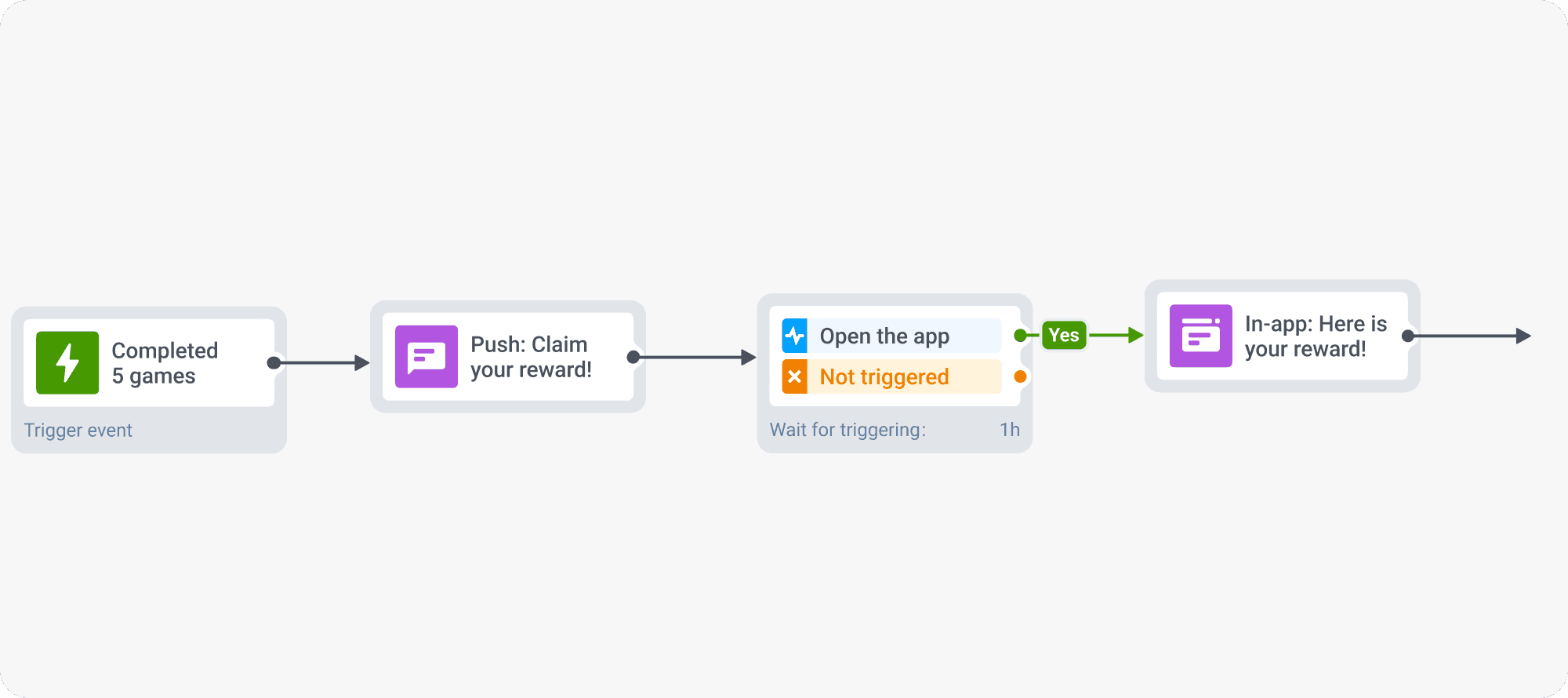
Later, when they’ve collected in-game currency, another in-app could inform them they can now access a new feature—the special items shop.
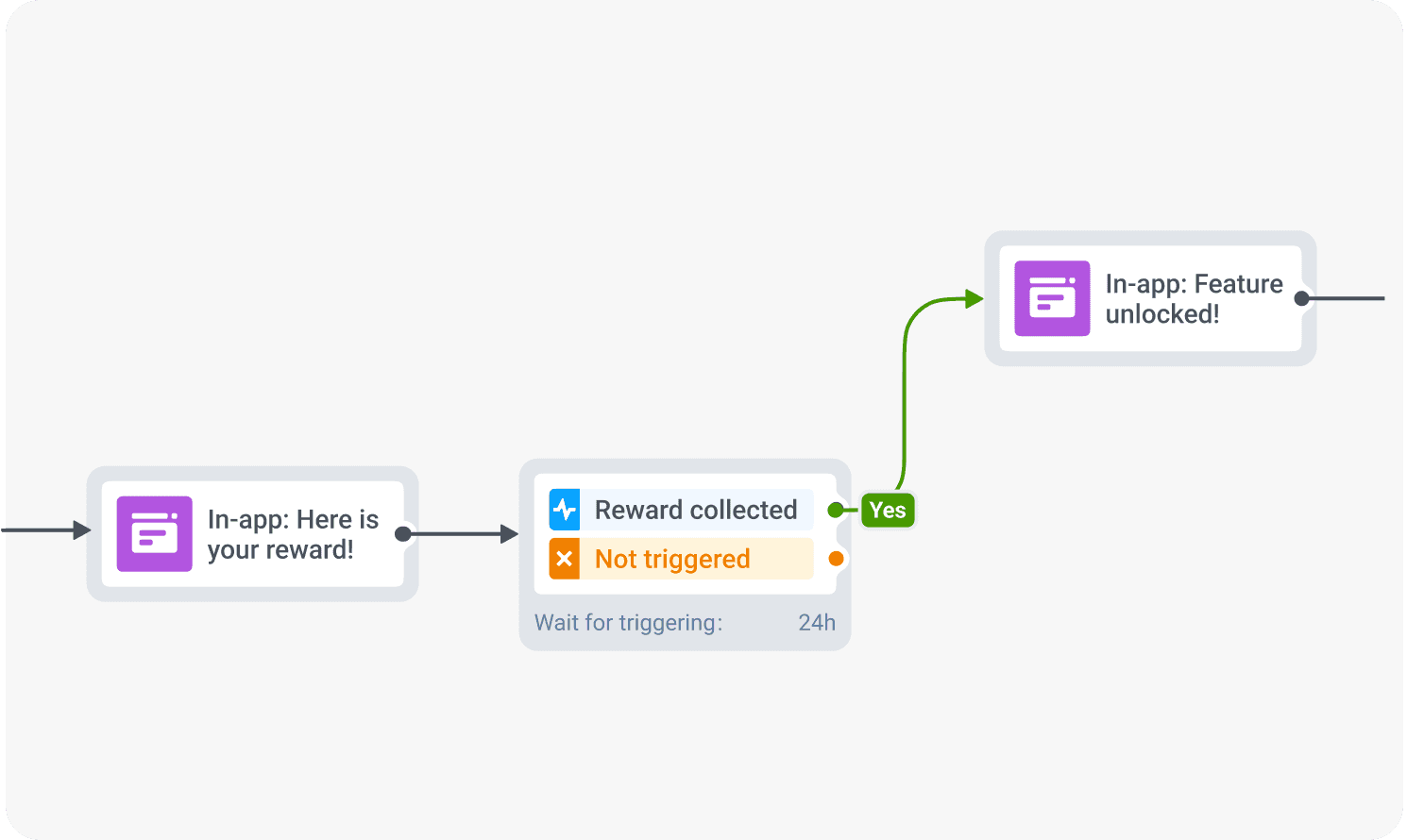
This progressive approach ensures continuous feature adoption.
Here’s proof in action:
Mobile puzzle games that personalize difficulty per player enjoy a 71% revenue boost. Surprisingly, the biggest jump comes from typically low-spending players who start spending more once the experience feels tailored. Such automated personalization could benefit a free-to-play game of any genre if it senses, adapts, and responds to each player in real time.
Re-engagement
Even the most engaged users can eventually become inactive.
Automated re-engagement campaigns bring users back by sending personalized messages based on their past behavior and preferences.
For example, if a player hasn’t opened the game for 3 days, a push notification about new daily challenges or rewards can recapture their attention.

For players inactive for 7+ days, offer a special comeback bonus in a triggered push and email.

Effective automation isn’t just about communication—it’s about creating value-driven interactions that resonate with users and enhance their experience. Whether it’s tailored content, timely offers, or context-driven reminders, the goal is to foster meaningful connections that keep users coming back. This approach improves retention and builds long-term loyalty, turning casual users into brand advocates.
Renewals, upsells, and upgrades
Automation can also pinpoint the perfect moments for monetization.
Example: When free players complete all available levels in a game, show them premium content packages through an attractive in-app offer.

The real power comes from responding to user behavior, not just time-based triggers.
How to automate mobile app marketing campaigns
Building effective mobile marketing automation requires a powerful software tool and a smart strategy.
Let’s go over a step-by-step approach for setting up your automation workflows to drive engagement and retention.
Step 1: Choose a platform that matches your needs
An automation platform is the foundation of your entire messaging strategy, as access to the necessary customer data and sophisticated sequences determines your campaign’s speed and personalization depth.
What your platform should offer:
| Feature | Why it matters |
|---|---|
| Unified messaging and data | Avoid fragmented systems that create data silos and slow down campaigns |
| Real-time triggers | Respond to user behavior instantly, not days later when it’s no longer relevant |
| Visual journey builder | Create complex flows without engineering resources while giving developers flexibility |
| Omnichannel logic | Manage push, in-app, email, and other channels in a single workflow |
| Smart segmentation | Target users based on their real-time behavior and preferences |
| Built-in A/B/n testing and ROI tracking | Measure what works and connect campaigns directly to business outcomes |
| Scalable pricing | Avoid platforms that become prohibitively expensive as you grow beyond certain user thresholds |
| Fit into your workflows | If your dev team is building flows outside your automation tool, the tool isn’t the problem—your stack is. |
Watch out for red flags:
🚩 Lacks event granularity
🚩 Analytics limited to open rates
🚩 Requires dev support for every flow
🚩 Too complex—or too basic—for your needs
Step 2: Collect and activate meaningful user data
Most mobile marketing teams underestimate how much friction comes from weak data foundations, even before broken messaging.
Delayed event syncs, limited default tracking, and missing context lead to campaigns that are late, generic, or just plain wrong.
Don’t just collect and forget. All interactions should land in one place—ideally, along with every other feedback you hear from customers, like emails, support tickets, or sales calls. That’s how you can start seeing the full picture and spot trends, segment by behavior, and actually do something about it.
To build automated behavior-based journeys that are relevant, you need three things:
Real-time tracking: So campaign triggers fire at the right time
Event-level context: Not just “app opened,” but “screen visited” or “feature used”
Structured attributes: So you can segment users by plan, location, preferences, or past behavior
Example: In Pushwoosh Customer Journey Builder, our gaming app could configure user attributes like “SubscriptionTier” (Free, Premium, and Ultra) and “PlayerLevel” (numeric value) to track player progression.
Based on these attributes, the app team could create custom segments, like “Free plan users who reached level 10.”

Step 3: Create message sequences based on user behavior
Use real-time signals and attributes to create dynamic campaigns that adapt to each user’s behavior:
Triggers to launch flows based on specific user actions or inactions (e.g., user opened the app but didn’t complete a key goal)
Branching to adapt your next message based on what users do after receiving your initial communication
Triggers + delays to respond to engagement patterns
Multichannel logic to reach users via the best channels based on their responsiveness
Example: In Pushwoosh, we could target our “Free plan users who reached level 10” segment with an upgrade campaign.
A push notification will congratulate them on reaching level 10 and tease premium features.
If they open the app after receiving this notification, they’ll see an in-app message with specific premium benefits and a special discount offer.

To those who don’t open the app upon receiving the push notification, we’ll email more detailed information about premium benefits.

Finally, for players who click the in-app message but don’t complete the purchase, trigger a follow-up push notification a day later with an additional incentive.

This approach ensures we’re reaching users through their preferred channels while using real-time engagement signals.
Step 4: Run experiments to optimize results
Once you’ve built your basic flow, start improving performance with systematic testing. Mobile users are diverse, and what works for one segment might fail for another.
To discover the best-performing strategies, run controlled A/B/n tests that compare:
| Test element | What you’ll learn |
|---|---|
| Message timing | How timing sensitivity affects different user segments and actions |
| Content format | Which message formats drive engagement vs. conversion across different contexts |
| Channel sequencing | How channel preferences vary by user segment and message purpose |
| CTA framing | Which psychological triggers and language patterns stimulate action |
| Offer presentation | What value propositions convert different user segments |
| Message frequency | The optimal cadence for your specific audience before creating fatigue |
Example: In our game app, we could test different approaches for converting our “Free plan users who reached level 10” segment to premium subscriptions.
In Pushwoosh, add an A/B/n split node to randomly divide users between the two test paths.
Journey A → a functional push notification offer: “Upgrade now for 50% off”
Journey B → a benefit-focused push: “Unlock all premium levels and characters”

Define the conversion goal as “Subscription_Purchased” within 7 days.
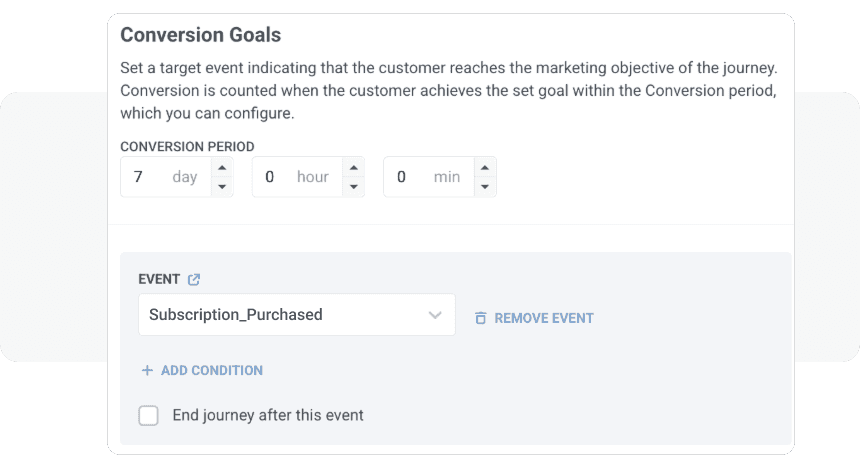
This structured approach to testing removes guesswork and lets data guide your campaign optimization efforts.
Step 5: Analyze and iterate
Look beyond single messages—analyze how your entire automation strategy performs:
- Monitor where users drop off in your journey flow to identify friction points
- Define campaign goals tied to real outcomes: purchases, retention, feature usage
- Use funnel analytics to pinpoint underperforming steps and prioritize improvements
Armed with this data, you can make targeted improvements, like creating a more compelling offer, simplifying the purchase flow, or adding additional touchpoints.
Pushwoosh: Built for the growth stage
Do you feel like you’ve outgrown basic tools but don’t need enterprise complexity?
Pushwoosh provides the ideal balance for mobile apps entering their maturity phase. Marketers managing apps in fintech, mobile games, news & media, e-commerce, food delivery, and other industries use it to retain and monetize their user bases.
The top features now available in Pushwoosh for free include:
| Feature | What you’ll like about it |
|---|---|
| Mobile-first foundation | Built for apps with millions of users, delivering high-volume messaging without lag |
| Unified journey orchestration | Manage push, in-apps, WhatsApp, SMS, and email campaigns from a single canvas |
| Advanced targeting and testing | Go beyond basic segmentation with behavioral triggers, RFM analysis, and comprehensive A/B/n testing |
| Efficient pricing model | Scales with your growth—no sudden price jumps or hidden fees common in enterprise platforms |
| Balanced for all teams | Developer-friendly SDKs and flexible API. Visual UI for marketers to use with minimum technical support. |
Let’s summarize the key tips to keep in mind:
Best practices for mobile marketing automation
1️⃣ Prioritize behavioral triggers: Schedule personalized messages based on user actions to boost engagement.
2️⃣ Design multi-touch sequences with fallbacks: Use channel switching (e.g., push → email → in-app) to increase reach and engagement.
3️⃣ Build incremental testing cycles: Test one variable at a time (timing, copy, visual, CTA) rather than complete message overhauls to stay focused.
4️⃣ Document and share insights: Create a playbook of what works for each user segment so engagement improves over time.
Many tools help with basic automation when you’re just starting out. But growing apps need platforms that scale with them.
Pushwoosh fills this gap with features built specifically for mobile apps that have found product-market fit and now need to optimize, not just experiment.




